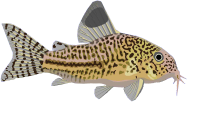L190 Help
- justL#s4me
- Posts: 25
- Joined: 20 Dec 2004, 05:29
- I've donated: $12.78!
- My images: 1
- Spotted: 1
- Location 1: Terre Haute IN. U.S.A.
L190 Help
I just got an L190 and it is not eating what can I do?
-
LimaShovel
- Posts: 115
- Joined: 23 Jan 2005, 18:14
- Location 1: New Caney Texas
- Interests: FISH
- Judazzz
- Posts: 119
- Joined: 12 Sep 2003, 19:24
- My images: 23
- My cats species list: 2 (i:0, k:0)
- Spotted: 18
- Location 1: Groningen, The Netherlands
- Interests: Loricarids/Piranha's, Photography, Webdesign, Travelling, Electric Guitar, Webdesign, Beer...
- Contact:
How long do you have that fish? And do you keep it in a quarantaine tank?
During the first days (sometimes longer), new fish are adapting to their new surroundings - a stressful experience for most fish, often resulting in extreme shyness and lack of appetite. If your fish doesn't eat the first few days, it shouldn't be a problem (as long as it was properly acclimatized by the store where you bought it, and doesn't have a sunken belly), but it should start accepting food within a week, imo. At first I'd try things like fresh veggies (cucumber, zucchini, egg plant, peas, lettuce, preboiled spinach) and algae pellets, as it's mainly a herbivorous species, and once acclimatized you can add occasional meaty foods to his diet as well (my little L190 loves fresh shrimp and mosquito larvae). Also make sure there's a few pieces of drift wood in his tank.
If possible, I'd keep it in a small quarantaine tank during the first weeks, so it can adapt without being disturbed/stressed by other fish. It enables you to monitor its progress as well as keeping an eye out on his health and food intake, and finding out what its favorite foods are.
Good luck.
During the first days (sometimes longer), new fish are adapting to their new surroundings - a stressful experience for most fish, often resulting in extreme shyness and lack of appetite. If your fish doesn't eat the first few days, it shouldn't be a problem (as long as it was properly acclimatized by the store where you bought it, and doesn't have a sunken belly), but it should start accepting food within a week, imo. At first I'd try things like fresh veggies (cucumber, zucchini, egg plant, peas, lettuce, preboiled spinach) and algae pellets, as it's mainly a herbivorous species, and once acclimatized you can add occasional meaty foods to his diet as well (my little L190 loves fresh shrimp and mosquito larvae). Also make sure there's a few pieces of drift wood in his tank.
If possible, I'd keep it in a small quarantaine tank during the first weeks, so it can adapt without being disturbed/stressed by other fish. It enables you to monitor its progress as well as keeping an eye out on his health and food intake, and finding out what its favorite foods are.
Good luck.





